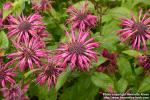2.24 Monarda.
 Latin name: Monarda didyma and other Monarda species.
Latin name: Monarda didyma and other Monarda species.
2.24.1 Growing Monarda
From: jnewbo.aol.com (Jnewbo)
My Monarda didyma 'Cambridge Scarlet' (the most common one) doesn't stay in place; it moves forward on flat stems near the surface. That means it creeps forward and needs to be divided and resituated every two-three years or so. It also is prone to mildew - but the crown-like scarlet blooms are fabulous.
A more well-behaved variety is the pink one, 'Croftway Pink'; it has more lanceolate leaves and smaller blooms, but the bees (including hummingbird-moth) love it, and it enlarges in the more traditional way, increasing the clump rather than traveling all over the garden.
Both bloom about three weeks, maybe more (sometimes I get "double" and even "triple decker" crowns on the red one). After that clip back and you may get more smaller blooms after a while.
From: Tristan Hatton-Ellis <Tristan.Hatton-Ellis.bris.ac.uk>
Both 'Croftway Pink' and 'Cambridge Scarlet' are rather mildew-prone. You may be interested to know that there are a whole range of new hybrids that have come out, bearing the names of the signs of the zodiac, that are much more mildew-resistant. They come in colours from purple through red and pink to white.
Monardas are also much less prone to getting mildew (and also grow and flower much better) in a dampish soil, or at least in a place where they do not get too dry in summer.
an354.FreeNet.Carleton.CA (Barbara)
Monarda didyma, also known as Bergamot and Bee Balm is a hardy perennial which grows 2-3 feet tall. Bees love it.
The plant spreads fairly quickly through its root system. Divide every three years, discarding the dead centre of the root. The plant will grow well in sun or part shade. The flowers last 4-6 weeks.
2.24.3 Using / preserving Monarda
From: an354.FreeNet.Carleton.CA (Barbara)
Monarda didyma, Bergamot or Bee Balm: The leaves dry well and can be used to make a tea that tastes like Earl Grey tea.
From: jnewbo.aol.com (Jnewbo)
The leaves and flowers of Cambridge scarlet are marvelous, bergamotty-flavored things, though I found the tea rather scratchy on the throat.
From: Marylin.Kraker.bbs.c4systm.com (Marylin Kraker)
Mondarda does make good tea, which is why it's also called Oswego tea. It's not the same as the bergamot in Earl Grey, which is a tropical citrus.
From: Conrad Richter <conrad.richters.com>
Both the leaves and flowers can be used. The flowers, of course, add nice colour. Some say that the flowers have a more delicate flavour, and of the various varieties, the red bergamot is the creme-de-la-creme.
2.24.5 Monarda and the bergamot flavor in Earl Grey tea
>So I heard from someone that bee balm is sorta-kinda the same plant that gives Earl Grey tea its distintive taste. Is this true?
From hetta.saunalahti.fi:
No, it isn't. The flavor in Earl grey tea comes from the bergamot orange, Citrus aurantia var. bergamia. Monarda just has the same flavor, so you -can- make your own Earl grey tea using Monarda leaves. Storebought Earl grey uses abovementioned citrus.

